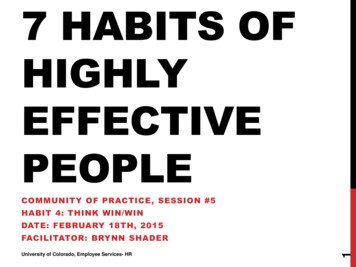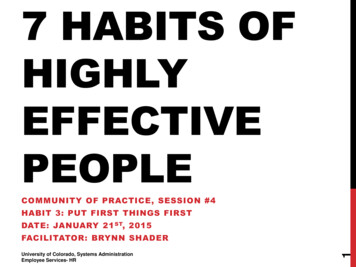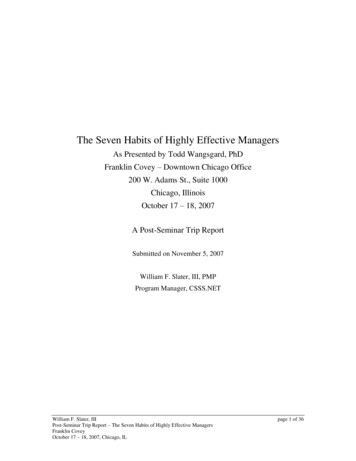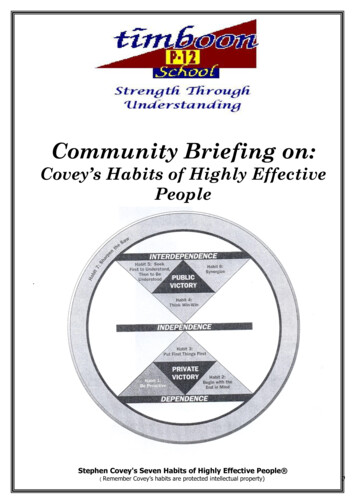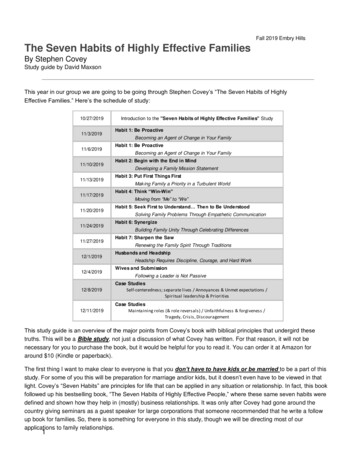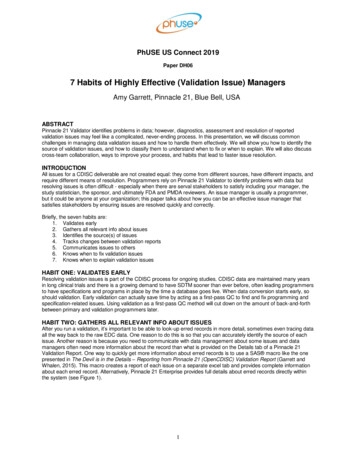
Transcription
PhUSE US Connect 2019Paper DH067 Habits of Highly Effective (Validation Issue) ManagersAmy Garrett, Pinnacle 21, Blue Bell, USAABSTRACTPinnacle 21 Validator identifies problems in data; however, diagnostics, assessment and resolution of reportedvalidation issues may feel like a complicated, never-ending process. In this presentation, we will discuss commonchallenges in managing data validation issues and how to handle them effectively. We will show you how to identify thesource of validation issues, and how to classify them to understand when to fix or when to explain. We will also discusscross-team collaboration, ways to improve your process, and habits that lead to faster issue resolution.INTRODUCTIONAll issues for a CDISC deliverable are not created equal: they come from different sources, have different impacts, andrequire different means of resolution. Programmers rely on Pinnacle 21 Validator to identify problems with data butresolving issues is often difficult - especially when there are serval stakeholders to satisfy including your manager, thestudy statistician, the sponsor, and ultimately FDA and PMDA reviewers. An issue manager is usually a programmer,but it could be anyone at your organization; this paper talks about how you can be an effective issue manager thatsatisfies stakeholders by ensuring issues are resolved quickly and correctly.Briefly, the seven habits are:1. Validates early2. Gathers all relevant info about issues3. Identifies the source(s) of issues4. Tracks changes between validation reports5. Communicates issues to others6. Knows when to fix validation issues7. Knows when to explain validation issuesHABIT ONE: VALIDATES EARLYResolving validation issues is part of the CDISC process for ongoing studies. CDISC data are maintained many yearsin long clinical trials and there is a growing demand to have SDTM sooner than ever before, often leading programmersto have specifications and programs in place by the time a database goes live. When data conversion starts early, soshould validation. Early validation can actually save time by acting as a first-pass QC to find and fix programming andspecification-related issues. Using validation as a first-pass QC method will cut down on the amount of back-and-forthbetween primary and validation programmers later.HABIT TWO: GATHERS ALL RELEVANT INFO ABOUT ISSUESAfter you run a validation, it’s important to be able to look-up erred records in more detail, sometimes even tracing dataall the way back to the raw EDC data. One reason to do this is so that you can accurately identify the source of eachissue. Another reason is because you need to communicate with data management about some issues and datamanagers often need more information about the record than what is provided on the Details tab of a Pinnacle 21Validation Report. One way to quickly get more information about erred records is to use a SAS macro like the onepresented in The Devil is in the Details – Reporting from Pinnacle 21 (OpenCDISC) Validation Report (Garrett andWhalen, 2015). This macro creates a report of each issue on a separate excel tab and provides complete informationabout each erred record. Alternatively, Pinnacle 21 Enterprise provides full details about erred records directly withinthe system (see Figure 1).1
Figure 1. Example of record details from Pinnacle 21 EnterpriseHABIT THREE: IDENTIFIES THE SOURCE(S) OF ISSUESIn order to understand where quality problems originate, it’s important to identify the source of each issue andcategorize it. Categories can also be used as a way to determine which issues need to be delegated to other peoplefor resolution (for example, data collection issues should be assigned to data management). One way this is achievedis by assigning a primary source to each issue. In Pinnacle 21 Enterprise, users can make use of tags to categorizeeach issue by its source; the tag(s) assigned will be automatically exported to the validation report. Figure 2 is anexample of tagging issues in Pinnacle 21 Enterprise. Alternatively, you can directly type the issue source into Excelvalidation report. Most issues will fall into one or more of the following categories: data collection error programming/spec error metadata (define.xml) sponsor-defined addition study is ongoing false positiveFigure 2. Example of Pinnacle 21 Enterprise issue table with tags applied to denote the issue sourceHABIT FOUR: TRACKS CHANGES BETWEEN REPORTSValidation is an ongoing process and it’s important to track the delta from one validation report to the next so that youcan determine when new issues are occurring and how quickly known issues are being resolved. There are three typesof issues to track between validations: new issues, resolved issues, and issues that are on both reports (possiblyaffecting a different number of records). When the same issue is present in both reports, prior comments should becopied from one report to the next, as applicable. One way to track the delta between validation reports is to use aprogram (SAS macro or other application) to compare the two reports together and produce a consolidated report withcomments carried forward. Another option is Pinnacle 21 Enterprise, which automatically copies issue comments fromone validation report to the next and has a feature that allows users to easily compare any two versions of a validationreport (see Figure 3).2
Figure 3. Example validation report comparison report filtered to only show new issuesHABIT FIVE: COMMUNICATES ISSUES TO OTHERSThe Pinnacle 21 Validation Report can serve as a communication device and be distributed to peers, managers andother stakeholders. Since all stakeholders may not be well-versed in CDISC, you should mark-up the validation reportfor better consumption. You should clearly state the source of an issue, who is responsible for resolving it, andprovide any extra information that may be needed about an issue. Pinnacle 21 Enterprise allow s users to assignissues to users, tag issues with their source, and provide comments about an issue, all of which are automaticallyexported to the Validation Report as depicted in Figure 4.Figure 4. Sample Pinnacle 21 Enterprise Validation Report with comments, assignee, tags, and explanations prepopulated based on information provided in the Enterprise systemHABIT SIX: KNOWS WHEN TO FIX VALIDATION ISSUESAn effective issue manager is one that knows when and how to fix each issue. You should understand the risk of eachissue and prioritize fixing issues that have the highest impact on regulatory review. The FDA is no longer publishingseverity, but it can still be used as a proxy for impact level; Errors and Reject rules usually have the highest impact onreview. Pinnacle 21 Enterprise provides review impact for each issue, as show in Figure 5, and recommends that youfix issues with high review impact first. In general, data collection errors, programming/spec errors, and issues relatedto the define.xml (issue with DD prefix) should always be fixed while issues due to an ongoing study should resolvenaturally overtime.3
Figure 5. Sample issue summary table with Review Impact highlightedKnowing how to fix each issue is challenging for any one individual, leading some companies to maintain a documentwith instruction guidance for how to fix the most common issues. This kind of document is especially helpful to morejunior members of the team. An example of one such document can be found in the paper entitled Common Pinnacle21 Report Issues: Shall we Document or Fix (Gupta, 2018). Pinnacle 21 Enterprise provides fix-tips for issues as welland can be customized for an organization (see Figure 6.)Figure 6. Same issue detail with Pinnacle 21 Fix tips providedHABIT SEVEN: KNOWS WHEN TO EXPLAIN VALIDATION ISSUES4
No study is perfect and there will always be a subset of pesky validation issues just won’t go away. Any issue thatcannot be fixed, even false positives, should be explained in the Reviewer’s Guide. Best Practice for ExplainingValidation Results in the Study Data describes a good explanation as “one that conveys transparency about the studydata and increases the reviewability” (Kelly, 2018).It’s a best practice to explain issues consistently across an organization. To keep explanations consistent, some issuemanagers keep a list of standard explanations with bracket placeholders for study specific information and then copythese explanations into the Reviewer’s Guide either manually or with a merge process. Another option is to usePinnacle 21 Enterprise which allows users to upload standard explanations, apply them to issues and modify them asnecessary. These explanations will automatically be exported to the Reviewer’s Guide. Figure 7 shows anorganization’s standard explanation (right) and how it was applied to this study (left). Figure 8 shows how theexplanation would appear in the Reviewer’s Guide.Figure 7. Example of Pinnacle 21 Enterprise Suggested Explanation and how a standard explanation can becustomized with study-specific information.Figure 8. Example of a Reviewer’s Guide generated with Pinnacle 21 EnterpriseCONCLUSION5
Validation is a process and the individuals tasked with creating and interpreting the validation report need to beorganized and use the tools at their disposal to ensure an efficient end-to-end process. SAS macros can be utilized tomake some process tasks easier; users also have technologies like JIRA to create and manage issues. Pinnacle 21Enterprise offers several features specifically designed for issue management such as standard issue explanations andthe ability to assign a validation issue to a specific individual. Regardless of the technology that is used, a successfulvalidation issue manager knows the important of validating early, tracking the validation results, and communicatingfindings to the right individuals.REFERENCESAmy Garrett and Chris Whalen. The Devil is in the Details – Reporting from Pinnacle 21 (OpenCDISC)Validation Report. Proceedings of the PharmaSUG 2015 Conference.Ajay Gupta. Common Pinnacle 21 Report Issues: Shall we Document or Fix. Proceedings of thePharmaSUG China 2018 Conference.Kristin Kelly. Best Practice for Explaining Validation Results in the Study Data. Proceedings of thePharmaSUG 2018 Conference.RECOMMENDED READINGSergiy Sirichenko. Common Programming Errors in CDISC Data. Proceedings of the PharmaSUG 2017Conference.CONTACT INFORMATIONYour comments and questions are valued and encouraged. Contact the author at:Amy GarrettPinnacle 21, LLC1777 Sentry Parkway W Building 17, Suite 405Blue Bell, PAPhone: 614-505-9043Email: agarrett@pinnacle21.comWeb: www.pinnacle21.comBrand and product names are trademarks of their respective companies.6
7 Habits of Highly Effective (Validation Issue) Managers Amy Garrett, Pinnacle 21, Blue Bell, USA . Regardless of the technology that is used, a successful validation issue manager knows the important of validating early, tracking the validation resu

